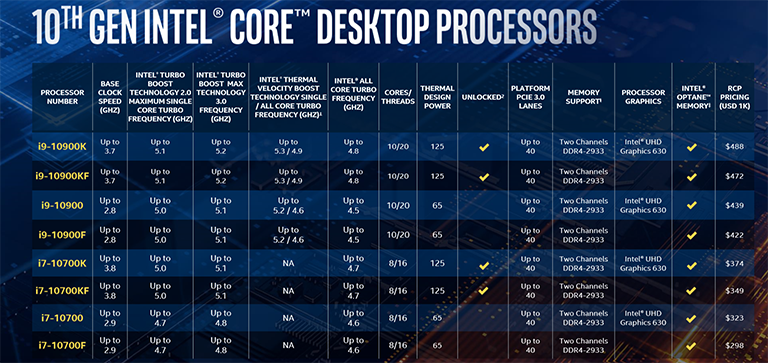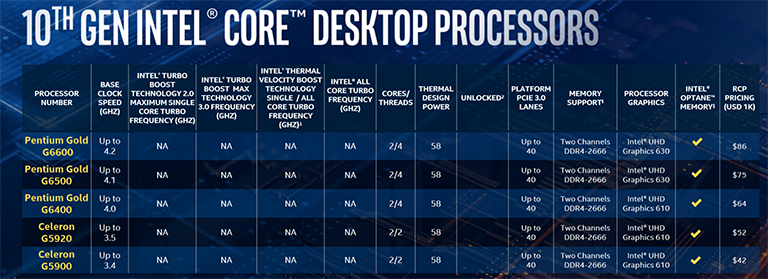Intel released a bunch of 10th Gen Core chips for gaming laptops earlier this month. Going by the codename Comet Lake H, and therefore built on a refined but ageing 14nm architecture, these 45W TDP processors have since found their way into high-performance laptops such as the Gigabyte Aero 17 HDR. There are six to choose from, with varying frequencies and cores/threads. Truth be told, they're not much of an improvement over the previous generation - a few percent here, a few percent there - and Intel's lack of progression is in obvious contrast to AMD's.
10th Gen Core in Branding Only
Now, the chip giant brings the same Comet Lake architecture to bear on the mainstream desktop market. All told, Intel releases 24 Core-based chips sporting the 10th Gen branding in i9, i7, i5 and i3 flavours, plus another eight using either Pentium Gold or Celeron. Quite the launch.
Before we get into speeds, feeds and thousand-unit pricing, a few words on what Comet Lake means to you, the enthusiast and gamer. Architecturally speaking, there's nothing much in it between these chips and the raft of Coffee Lake (9th Gen Core) that you're familiar with. That's disconcerting in its own right as those processors were released October 2018 onwards and represent minor improvements that have gone before. Make no mistake, Comet Lake S is a refinement of an old core, not the grounds-up design that the mobile-only Ice Lake is, yet both share 10th Gen branding.
Wider and Faster than Last-Gen
Key to these new chips' appeal is an expansion of core-and-thread counts from 8C/16T on 9th Gen Core to a maximum of 10C20T here. 25 percent extra physical resource is always welcome, of course, though it obviously lags behind the 16C32T capabilities of AMD's mainstream champ, Ryzen 9 3950X, so it's almost inevitable that Intel will continue to lose in heavily-threaded workloads.
What Intel lacks in sheer parallel muscle it hopes to make up for, at least to a reasonable degree, by cranking up the frequencies on each part. Such a play primes 10th Gen Core desktop processors as gaming champions thanks to high-frequency throughput on low core counts - the ideal situation for gaming - and dutifully markets them as such.
Getting to the actual models in a moment, it's worth investigating how Intel is claiming turbo boost frequencies of up to 5.3GHz from the Comet Lake S architecture. A couple of factors come to the fore. Firstly, continued teasing of the 14nm process node - Intel's been on it the best part of five years - increases efficiency with each generation, enabling top-end speed to be hiked without unduly troubling voltage. Careful consideration here adds 200-300MHz for each processor compared to its immediate predecessor.
Secondly, Intel has looked at the physical packaging properties and ascertained that better heat transfer can be enabled by reducing the thickness of the die whilst concurrently increasing the thickness of the integrated heatspreader. The reasons for doing so are simple. Silicon isn't a great conductor of heat while the copper-containing heatspreader is, to the tune of 3x. Shaving off 50-100 microns from the die, accounting for a 10 percent reduction, ought to reduce temperatures sufficiently to allow for a bit extra frequency headroom. That's the theory, anyway.
New Motherboards Needed - 400-series
Though AMD has clearly proved otherwise by having socket continuity throughout Ryzen generations that encompass a doubling of cores and improved architectures, Intel has chosen Comet Lake S as the break-off point with respect to pin layout and chipsets. The incumbent LGA1151v2, characterised best by Z390 models, is now redundant. 10th Gen Core desktop chips use an LGA1200 form factor that is both electrically and mechanically different from its predecessor. You know what that means, right? New 400-series chipsets designed for Comet Lake alone.
Intel's revealed little of any ancillary improvements in the chipset, probably because there aren't many. What we do know is that the mounting mechanism is the same as on current models, meaning you can reuse cooling, while the conduit to peripherals and slots remains at PCIe 3.0. There's also no addition to the Z390's 40 PCIe lanes. About all that can be said right now is that Z490 offers support for Intel's Ethernet i225 controller (Foxville), baked-in Wi-Fi 6 AX201 compatibility if the motherboard manufacturer chooses to take up CNVi properties, and memory support at DDR4-2933 speeds.
Expect to see H410, H470, B460, Q470 and, of course, enthusiast-class Z490 boards launched by the dozen today, but on the face of it, Intel remains firmly behind AMD on connectivity and bandwidth.
CPU Models
The four 10th Gen Core i9 chips feature 10 cores and 20 threads at their disposal, split evenly between IGP (old UHD 630) and non-IGP models. The 10900K uses a 125W PL1 TDP, up from 95W for the 9900K, though actual power may be substantially higher if motherboards accommodate a higher PL2 state, which will probably be needed to maintain an all-core 4.9GHz across 20 threads. These i9 models feature a couple of technologies for obtaining the very last drop of performance: Turbo Boost Max 3.0 and Thermal Velocity Boost (TVB). The former calculates the two best-performing cores and uses them in light-load situations whilst the latter opportunistically boosts to even higher frequencies if CPU temperature is below 70°C and sufficient power budget available.
Cranking up to 5.3GHz is a sure-fire way of winning the gaming benchmarks, where frequency remains king. Our favourite chip from this quartet is the Core i9-10900F. It's plenty fast yet delivers all of its goodness wrapped in a 65W TDP - perfect for a small, quiet system. Intel retains the smart caching arrangement as on 9th Gen - 2MB per core - so the top-line parts now have 20MB instead of 16MB.
10th Gen Core i7s are what 9th Gen Core i9s used to be. Why? Because they sport 8C16T across their four models, albeit at lower prices. There's no TVB here, though, yet peak and all-core speeds remain handsome. In fact, it would be interesting to put, say, the Core i7-10700K up against the Core i9-9900K and see which one comes out on top.
In stark contrast to the previous generation, it's hyperthreading everywhere for 10th Gen. Core i5 goes 6C12T - a layout that doesn't exist in 9th Gen - though official memory speed is bumped down to DDR4-2666 for reasons unknown. Frequencies remain good but we find it strange why the i5-10600K(F) needs 125W - surely Intel could have gone down to 95W here. As usual, we look more favourably on the 65W models.
Moving on down to Core i3, there's a much-needed boost by implementing a 4C8T topology that puts pressure on AMD Ryzen 3 series, and reason why the latest slew of chips from the rival also feature the same core-and-thread count. Adding hyperthreading here is of greatest importance, making us wonder why Intel chose to not use it for 9th Gen.
Then there's a raft of T-series chips built for 35W TDPs. It's good to see Intel keep the same cores and threads as on their full-power models, and these seven Core chips work well if absolute performance is not paramount. Having a 10C20T Core i9-10900T running at 35W is interesting because it should have also been made available for the latest laptops.
Intel vs. AMD Comparisons
Knowing pricing enables us to draw tentative comparisons of Intel and AMD's latest mainstream processors.
Mainstream Pricing Comparison At Select Points |
|||
|---|---|---|---|
| Price | Intel 10th Gen Core |
AMD Ryzen 3rd Gen |
|
| $500+ | - |
R9 3950X (16/32) |
|
| $450-$500 | i9-10900K (10/20) |
R9 3900X (12/24) |
|
| $400-$450 | i9-10900 (10/20) |
- |
|
| $350-$400 | i7-10700K (8/16) |
R7 3800X (8/16) |
|
| $300-$350 | i7-10700 (8/16) |
R7 3700X (8/16) |
|
| $250-$300 | i5-10600K (6/12) |
- |
|
| $200-$250 | i5-10600 (6/12) |
R5 3600X (6/12) |
|
| $150-$200 | i5-10500 (6/12) |
R5 3600 (6/12) |
|
| $100-$150 | i3-10100 (4/8) |
R3 3300X (4/8) |
|
| $50-$100 | PG G-6600 (2/4) |
R3 3100 (4/8) |
|
The $50 banding bring a few wrinkles into play - some processors are right at the top end, others are not - yet this is still useful as a ready reckoner based on budget alone.
Up at the top of the mainstream market, AMD's ability to house 16C32T is unmatched. It will be so for quite some time, too. The performance battle between Core i9-10900K and Ryzen 9 3900X is sure to be interesting. AMD enjoys more cores and threads but Intel ought to run its chips at higher sustained speeds. That means better gaming performance and pretty close multithreaded numbers. Time will tell.
Changing the core-and-thread count between Core generations works well in matching up to what AMD currently offers. The new i7s compare favourably to R7 3800X and 3700X. Again, though, they may well be better in gaming and heavy-load situations thanks to their higher peak and sustained speeds.
There is only one instance where Intel ought to fall behind by a reasonable margin, assuming AMD doesn't move on pricing. One is at the very low end, where Pentium battles the entry-level Ryzen 3. Everywhere else is a fair fight.
Following on from this launch, we're expecting AMD to reposition itself as the price-to-performance champion by shifting its Ryzen 3rd Gen pricing down across the stack.
The Wrap
Intel doesn't have many choices with its 10th Gen Core for the desktop. The only sensible move has been to employ a refined 14nm process known as Comet Lake S. This enables a few things to happen. There are higher frequencies across the board, there's a 10C20T performance part, and tangentially, having hyperthreading on every chip is a boon.
Further movements in pricing underscore that Intel draws on-paper parity with AMD's latest processors, and the choice of going Core or Ryzen isn't clear cut any more. AMD has the better platform support; Intel offers higher peak and sustained CPU speeds.
Given what it had to play with, 10th Gen Core is shaping up to be more intriguing that we originally thought. Roll on the benchmarks in May.


















